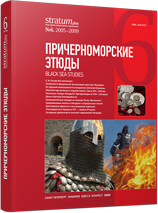Этнографическое изучение населения Юга Украины в ХІХ – начале ХХ вв.
Ethnographic Studies of the Southern Ukraine Population in 19th – Early 20th Century
Author(s): Yuriy G. RozumenkoSubject(s): History, Anthropology, Social Sciences, Cultural Anthropology / Ethnology, 19th Century, Scientific Life
Published by: Издательский дом Stratum, Университет «Высшая антропологическая школа»
Keywords: Ethnographic Studies; Southern Ukraine Population; Russian Geographic Society
Summary/Abstract: The article shows that the need and the interest to ethnographic studies evolve in a certain social-economic situation. The author proves that the ethnographic thought in the region was formed under a crisis of class ideology and psychology, discrediting aristocratic arrogance shown towards ‘plain’ people and the developing belief that the future of the country only depends on the working lower classes of the society. During this period, the ethnic preconditions for development of ethnographic studies of the same phenomenon lay in development of bourgeois nations from the old ethnicities, dramatization and complication of ethnic processes, relations within and between the developing nations. Development of ethnography was encouraged by developing self-identities of the young nations.Odessa Society of History and Antiquities and the Ethnographic Division of the Russian Geographic Society pioneered in ethnographic studies of the local population in 1800-1850. They focused on study of spiritual culture and folklore and were publishing Old Slavic written records. Many of their works became the only sources on traditional culture and inter-ethnic relations among South Ukraine population during the Soviet regime.Since 1865, professors and lecturers of the Novorossiysk University had taken active part in studying popular culture of South Ukraine population, with Savialiani, F. I. Leontovich, A. V. Florovsky, A. I. Almazov, V. I. Grigorovich, V. I. Mochulsky, Ya. G. Popruzhenko among them. The value of their work consists in rich factual material, which they were the first ones to offer for scientific discussion. Particularly, they discovered some very precious examples of Old Slavic writing, different written sources on history of the region, materials on Bulgarian migrants.A positive role in many ethnographic studies was played by the ethnographic program adopted by the VI All-Russia Archaeological Convention. It encouraged wide ethnographic research projects, including local history studies in South Ukraine. Active involvement of the local intelligentsia in studying traditional culture of the local ethnic groups was a peculiar feature of the second stage in development of the regional ethnography. Compared with the previous stage, studies of the local traditional culture became more regular. However, because majority of the collectors did not have professional training, their contributions were mainly descriptive. Their scientific value consists just in timely documentation of some elements of culture and everyday life that cannot be seen today.Local museums in 1850-1900, along with the study of historical and archaeological sites, engaged in collecting local ethnographic material.Local representatives of ‘democratic ethnography’, such as V. N. Yastrebov, P. Z. Ryabkov, A. I. Markevich, engaged in studies of South Ukraine traditional culture in its intrinsic connection with social and economic life.
Journal: Stratum plus. Археология и культурная антропология
- Issue Year: 2009
- Issue No: 6
- Page Range: 478-538
- Page Count: 61
- Language: Russian
- Content File-PDF

